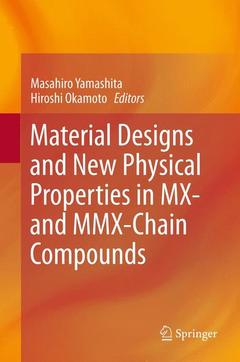Material Designs and New Physical Properties in MX- and MMX-Chain Compounds, 2013
Coordonnateurs : Yamashita Masahiro, Okamoto Hiroshi

This is the first book to comprehensively address the recent developments in both the experimental and theoretical aspects of quasi-one-dimensional halogen-bridged mono- (MX) and binuclear metal (MMX) chain complexes of Pt, Pd and Ni. These complexes have one-dimensional electronic structures, which cause the various physical properties as well as electronic structures. In most MX-chain complexes, the Pt and Pd units are in M(II)-M(IV) mixed valence or charge density wave (CDW) states due to electron-phonon interactions, and Ni compounds are in Ni(III) averaged valence or Mott-Hubbard states due to the on-site Coulomb repulsion. More recently, Pd(III) Mott-Hubbard (MH) states have been realized in the ground state by using the chemical pressure. Pt and Pd chain complexes undergo photo-induced phase transitions from CDW to MH or metal states, and Ni chain complexes undergo photo-induced phase transitions from MH to metal states. Ni chain complexes with strong electron correlations show tremendous third-order optical nonlinearity and nonlinear electrical conductivities. They can be explained theoretically by using the extended Peierls-Hubbard model. For MMX-chain complexes, averaged valence, CDW, charge polarization, and alternating charge polarization states have been realized by using chemical modification and external stimuli, such as temperature, photo-irradiation, pressure, and water vapor. All of the electronic structures and phase transitions can be explained theoretically.
1 General Intoruduction S. Takaishi and M. Yamashita.- 2 MX-Chain Compounds.- 2.1 Pt(II)-Pt(IV) and Pd(II)-Pd(IV) Mixed-Valence Compounds H. Matsuzaki and H. Okamoto.- 2.2 Ni(III) Mott-Hubbard Compounds S. Takaishi and M. Yamashita.- 2.3 Pd(III) Mott-Hubbard Compounds S. Takaishi and M. Yamashita.- 2.4 Photoinduced Phase Transitions in MX-Chain Compounds H. Matsuzaki and H. Okamoto.- 2.5 Nonlinear Electrical Conductivity, Current Oscillation and Its Control in Halogen-Bridged Nickel(III) Compounds H. Kishida and A. Nakamura.- 2.6 Gigantic Third-Order Optical Nonlinearity of Halogen-Bridged Nickel(III) Compounds H. Kishida and H. Okamoto.- 2.7 Theory of MX-Chain Compounds K. Iwano.- 3 MMX-Chain Compounds.- 3.1 Crystal Structures and Properties of MMX-Chain Compounds Based on Dithiocarboxylato-Bridged Dinuclear Complexes M.Mitsumi.- 3.2 POP-Type MMX-Chain Compounds with Binary Counter-Cations and Vapochromism H. Iguchi, S. Takaishi and M. Yamashita.- 3.3 Photoinduced Phase Transitions in MMX-Chain Compounds H. Matsuzaki and H. Okamoto.- 3.4 Theory of MMX-Chain Compounds K. Yonemitsu.
Low-dimensional semiconductors with exciting optical properties are extensively discussed
Physical properties arising from quasi-one-dimensional electronic systems are covered
Various photoinduced phase transitions and their dynamics are presented
Includes supplementary material: sn.pub/extras
Date de parution : 12-2012
Ouvrage de 270 p.
15.5x23.5 cm
Disponible chez l'éditeur (délai d'approvisionnement : 15 jours).
Prix indicatif 105,49 €
Ajouter au panier


